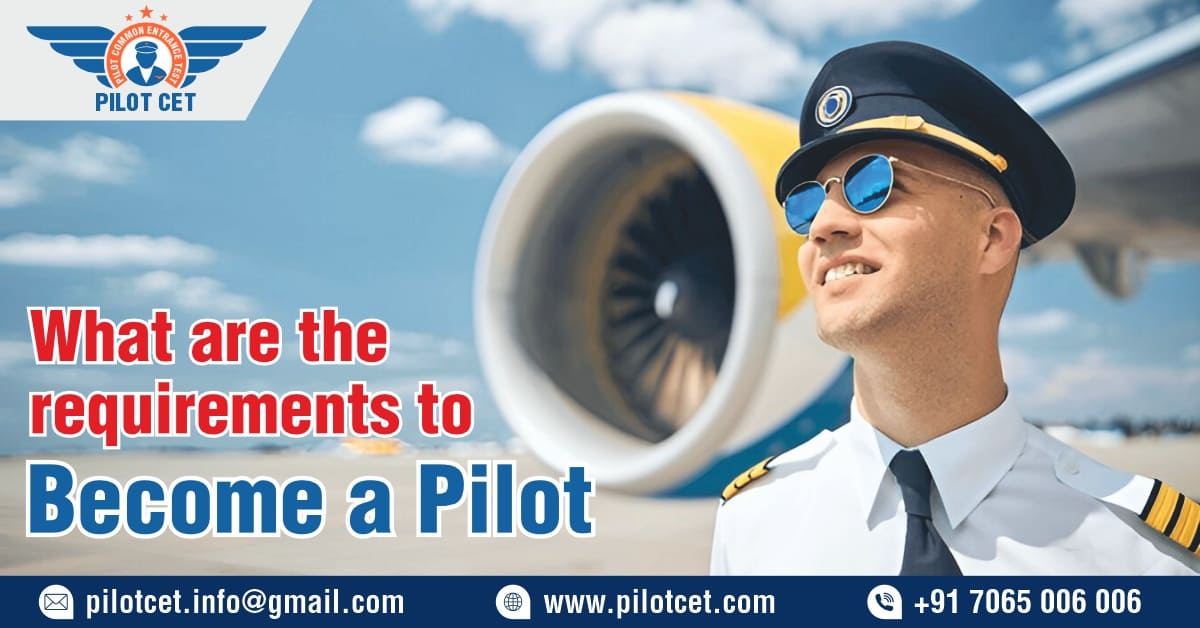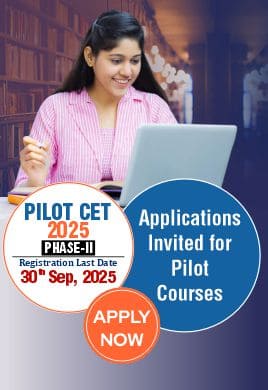
What are the requirements to become a pilot?
Before staring the pilot journey student often wonder about "what are the requirements to become a pilot"? So here we are, students need to meet certain requirements for pilot training in India. These requirements cover age, education, medical fitness and the number of flying hours which differ based on the license. Choosing the right license will depend on your career goals for example PPL (Private Pilot License) for hobby flying, CPL (Commercial Pilot License) for commercial flying and ATPL (Airline Transport Pilot License) for airline captains.
Knowing the exact requirements to become a pilot is very important toward the future your aviation career. Once you meet the basic pilot training requirement then you can move ahead with confidence and plan for your dream profession. Understanding these requirements early helps you save time, money and effort during your pilot journey.
Overview
|
License |
Sub-License Type |
Minimum Age |
Education |
Medical |
Flying Hours |
|
PPL |
PPL (A) - Aeroplane |
17 yrs |
10th Pass |
Class 2 |
40 hrs |
|
PPL (H) - Helicopter |
17 yrs |
10th Pass |
Class 2 |
40 hrs |
|
|
CPL |
CPL (A) - Aeroplane |
18 yrs |
12th PCM |
Class 1 |
200 hrs |
|
CHPL - Helicopter |
18 yrs |
12th PCM |
Class 1 |
150 hrs |
|
|
ATPL |
ATPL (A) - Aeroplane |
21 yrs |
12th PCM |
Class 1 |
1500 hrs |
|
ATPL (H) - Helicopter |
21 yrs |
12th PCM |
Class 1 |
1000 hrs |
Educational Qualification
- PPL (Aeroplane & Helicopter):
- Must have passed Class 10th from a recognized board.
- CPL (Aeroplane & Helicopter)
- 10+2 with Physics, Chemistry & Mathematics (PCM) with a recognized board or equivalent polytechnic diploma.
- ATPL (Aeroplane & Helicopter)
- 10+2 with Physics, Chemistry & Mathematics (PCM) with a recognized board or equivalent polytechnic diploma.
If you have chosen a different stream in school but want to be a pilot you can still achieve your dream. You just need to clear Physics and Mathematics later through NIOS or an equivalent board to fulfill DGCA's requirement.
Age
- For PPL (A/H), the minimum age is 17 years.
- For CPL (A/H) you need to be 18 years or older.
- For ATPL (A/H) which is the highest qualification, you must be at least 21 years old.
Medical Fitness
- PPL (A/H): You must have a DGCA-approved Class 2 Medical Certificate. This covers basic health checks like eyesight, blood pressure, hearing and overall physical condition to ensure you are fit to operate an aircraft at a non-commercial level.
- CPL (A/H) & ATPL (A/H): You must have a DGCA-approved Class 1 Medical Certificate. This is more comprehensive and includes advanced tests such as ECG, lung function, blood tests and detailed eye and hearing exams to confirm your ability to handle the high demands of professional and airline flying.
DGCA Modules
To become a pilot students need to qualify the 6 DGCA modules examinations as well. After qualifying these student can further pursue flying training. Below is given all 6 modules related to pilot training:
|
Module |
Description |
|
1. Air Regulations |
Rules, laws, and procedures governing civil aviation. |
|
2. Aviation Meteorology |
Weather systems, forecasts and their effects on flying. |
|
3. Aviation Regulations |
DGCA rules, licensing regulations and operational procedures. |
|
4. Technical - General |
Basics of aircraft/helicopter components, engines and systems. |
|
5. Technical - Specific |
Detailed knowledge of aircraft/helicopter type, performance and limitations. |
|
6. RTR |
Procedures and protocols for communicating with ATC. |
Flying Hours Requirements
To become a pilot profession, you must complete specific flying hours based on your chosen license PPL, CPL or ATPL. These hours vary by license type and include solo, cross-country and instrument flying. Below is given complete detail related to the flying hours required:
PPL (Private Pilot License)
|
Details |
PPL (A) |
PPL (H) |
|
Total Flying Hours |
40 hours |
40 hours |
|
Solo Flying |
20 hours |
15 hours |
|
Dual Flying |
10 hours |
10 hours |
CPL (Commercial Pilot License)
|
Details |
CPL-(A) |
CHPL-(H) |
|
Total Flying Hours |
200 hours |
150 hours |
|
Pilot-in-Command (PIC) |
100 hours |
50 hours |
|
Cross-Country Flying |
20 hours |
20 hours |
|
Instrument Flying |
10 hours |
10 hours |
ATPL (Airline Transport Pilot License)
|
Details |
ATPL-(A) |
ATPL- (H) |
|
Total |
1500 hours |
1000 hours |
|
Cross-Country |
500 hours |
350 hours |
|
Night Flying |
100 hours |
100 hours |
|
Pilot-in-Command (PIC) |
250 hours |
200 hours |
Examination & Licensing
After completing the pilot license training students have to pass the DGCA examinations and flying test to get their pilot license. This process includes written exams, practical flying test with a certified examiner and verification of medical fitness. A successful completion will make the student eligible to become an aircraft Pilot-in-Command (PIC) operating within the DGCA regulations.
|
Stage |
Description |
|
Written Exams |
Conducted by DGCA on ground modules: Air Regulations, Meteorology, Air Navigation, Aircraft Technical (General and Specific) and RTR. Tests theoretical knowledge. |
|
Flying Test |
Practical assessment by a DGCA-certified examiner covering takeoffs, landings, solo flying, cross-country navigation and basic instrument flying. |
|
Licence Issuance |
After passing written exams, flying test and holding a valid DGCA medical certificate, DGCA issues the pilot license allowing the holder to fly as Pilot-in-Command. |
Entrance Exam & Admission
Aspiring pilot students can give entrance exam like Pilot CET or AME CET to get admission in top DGCA approved flying schools and get scholarships to reduce their financial burden. And they can make their career in commercial pilot, airline captain charter pilot and many more. Below is given step by step guide to from giving the exam to getting the admission:
Step 1: Submission of Application Form
- Visit the official Pilot CET website at https://pilotcet.com.
- Fill out the application form accurately with all the required details.
Step 2: The Entrance Exam
- Appear for the Pilot CET exam, which tests your knowledge in Physics, Mathematics, English & reasoning ability.
Step 3: Counseling and Seat Allotment
- After the results are announced, qualified students will be invited for counseling sessions.
- During counseling students can choose their preferred pilot training institute and course (SPL, PPL, CPL or ATPL) based on their AIR rank and seat availability.
Step 4: Admission & Fee Payment
- Once your seat is allotted, proceed with document verification and pay the required admission fee to confirm your enrollment in the chosen pilot training program.
After completing above mentioned requirements such as education, medical fitness and flight training. A student can turn their passion of flying into a well-respected pilot profession. With dedication and proper training aspiring pilots can turn their dream of flying into a successful aviation career.

Recent Articles
- What is Commercial Pilot Course?
- PPL (A) Licence
- CPL Holder Meaning
- What are the requirements to become a pilot?
- What is a Commercial Airline Pilot?
- CPL Aviation
- What should I do after 12th to become a pilot?
- What is the eligibility to become a pilot?
- what is a commercial pilot license?
- Pilot Eligibility for Female
Frequently Asked Questions
To become a pilot you need to pass Class 12th with Physics and Math. You must be medically fit and clear DGCA exams. Flight training is also required.
read more..
Because flying needs basic knowledge of aircraft speed weight and weather. Physics and Math help you understand these concepts easily.
read more..
You can start training at 17 years. You can apply early so you are ready when you turn 17.
read more..
Start preparing after Class 10th or Class 12th. Early preparation makes the DGCA exams easier.
read more..
DGCA sets the rules for flying. Training in a DGCA approved school makes your license valid in India
read more..
Commercial Pilot License Commercial Helicopter Pilot License Private Pilot License Private Helicopter Pilot License
